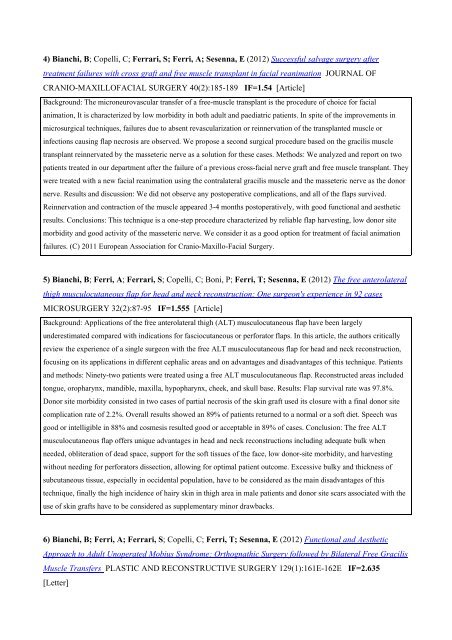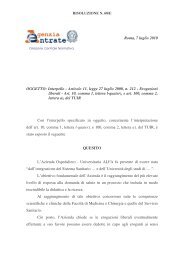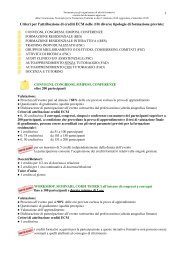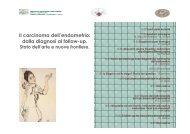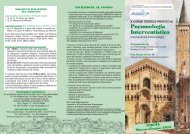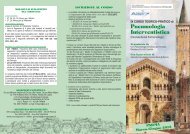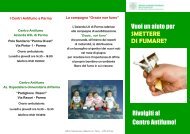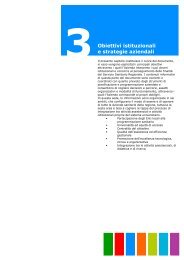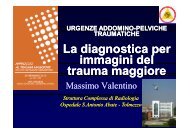COLLEGIO DI DIREZIONE - Azienda Ospedaliera di Parma
COLLEGIO DI DIREZIONE - Azienda Ospedaliera di Parma
COLLEGIO DI DIREZIONE - Azienda Ospedaliera di Parma
You also want an ePaper? Increase the reach of your titles
YUMPU automatically turns print PDFs into web optimized ePapers that Google loves.
4) Bianchi, B; Copelli, C; Ferrari, S; Ferri, A; Sesenna, E (2012) Successful salvage surgery after<br />
treatment failures with cross graft and free muscle transplant in facial reanimation JOURNAL OF<br />
CRANIO-MAXILLOFACIAL SURGERY 40(2):185-189 IF=1.54 [Article]<br />
Background: The microneurovascular transfer of a free-muscle transplant is the procedure of choice for facial<br />
animation, It is characterized by low morbi<strong>di</strong>ty in both adult and pae<strong>di</strong>atric patients. In spite of the improvements in<br />
microsurgical techniques, failures due to absent revascularization or reinnervation of the transplanted muscle or<br />
infections causing flap necrosis are observed. We propose a second surgical procedure based on the gracilis muscle<br />
transplant reinnervated by the masseteric nerve as a solution for these cases. Methods: We analyzed and report on two<br />
patients treated in our department after the failure of a previous cross-facial nerve graft and free muscle transplant. They<br />
were treated with a new facial reanimation using the contralateral gracilis muscle and the masseteric nerve as the donor<br />
nerve. Results and <strong>di</strong>scussion: We <strong>di</strong>d not observe any postoperative complications, and all of the flaps survived.<br />
Reinnervation and contraction of the muscle appeared 3-4 months postoperatively, with good functional and aesthetic<br />
results. Conclusions: This technique is a one-step procedure characterized by reliable flap harvesting, low donor site<br />
morbi<strong>di</strong>ty and good activity of the masseteric nerve. We consider it as a good option for treatment of facial animation<br />
failures. (C) 2011 European Association for Cranio-Maxillo-Facial Surgery.<br />
5) Bianchi, B; Ferri, A; Ferrari, S; Copelli, C; Boni, P; Ferri, T; Sesenna, E (2012) The free anterolateral<br />
thigh musculocutaneous flap for head and neck reconstruction: One surgeon's experience in 92 cases<br />
MICROSURGERY 32(2):87-95 IF=1.555 [Article]<br />
Background: Applications of the free anterolateral thigh (ALT) musculocutaneous flap have been largely<br />
underestimated compared with in<strong>di</strong>cations for fasciocutaneous or perforator flaps. In this article, the authors critically<br />
review the experience of a single surgeon with the free ALT musculocutaneous flap for head and neck reconstruction,<br />
focusing on its applications in <strong>di</strong>fferent cephalic areas and on advantages and <strong>di</strong>sadvantages of this technique. Patients<br />
and methods: Ninety-two patients were treated using a free ALT musculocutaneous flap. Reconstructed areas included<br />
tongue, oropharynx, man<strong>di</strong>ble, maxilla, hypopharynx, cheek, and skull base. Results: Flap survival rate was 97.8%.<br />
Donor site morbi<strong>di</strong>ty consisted in two cases of partial necrosis of the skin graft used its closure with a final donor site<br />
complication rate of 2.2%. Overall results showed an 89% of patients returned to a normal or a soft <strong>di</strong>et. Speech was<br />
good or intelligible in 88% and cosmesis resulted good or acceptable in 89% of cases. Conclusion: The free ALT<br />
musculocutaneous flap offers unique advantages in head and neck reconstructions inclu<strong>di</strong>ng adequate bulk when<br />
needed, obliteration of dead space, support for the soft tissues of the face, low donor-site morbi<strong>di</strong>ty, and harvesting<br />
without nee<strong>di</strong>ng for perforators <strong>di</strong>ssection, allowing for optimal patient outcome. Excessive bulky and thickness of<br />
subcutaneous tissue, especially in occidental population, have to be considered as the main <strong>di</strong>sadvantages of this<br />
technique, finally the high incidence of hairy skin in thigh area in male patients and donor site scars associated with the<br />
use of skin grafts have to be considered as supplementary minor drawbacks.<br />
6) Bianchi, B; Ferri, A; Ferrari, S; Copelli, C; Ferri, T; Sesenna, E (2012) Functional and Aesthetic<br />
Approach to Adult Unoperated Mobius Syndrome: Orthognathic Surgery followed by Bilateral Free Gracilis<br />
Muscle Transfers PLASTIC AND RECONSTRUCTIVE SURGERY 129(1):161E-162E IF=2.635<br />
[Letter]


